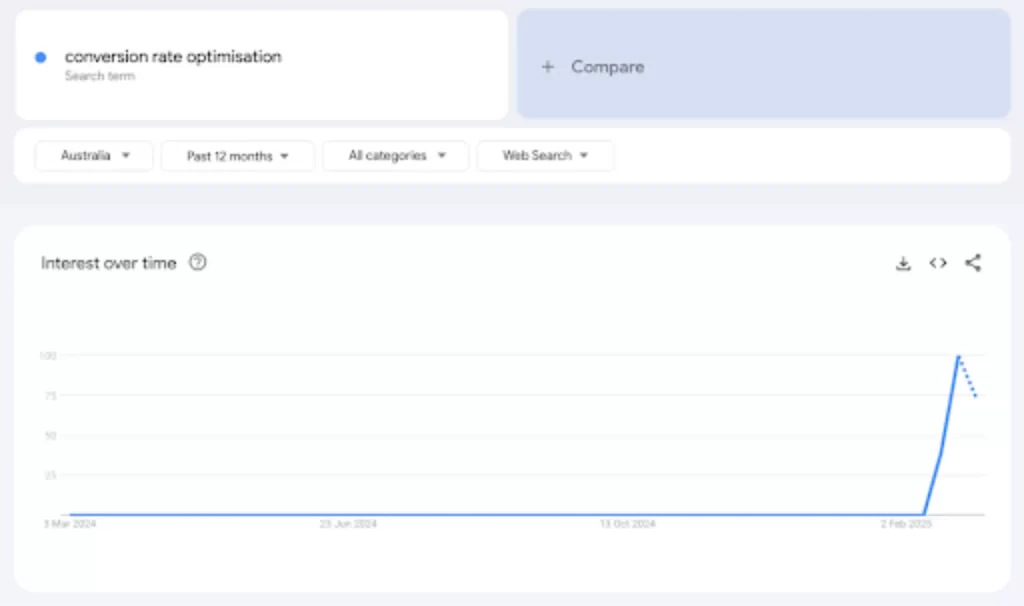Based on Google Trend Data, in the last 12 months in Australia, the search volume of Conversion Rate Optimisation has picked up. This indicates the awareness of its role in the digital marketing space.

Step Five: Data Validation
Regardless of where you are planning to run the conversion rate optimisation exercise from, firstly, you need to make sure that you’ve reached statistical significance before you decide to review your testing. This means that you need to have enough results to allow you to make an informed decision. It’s no good deciding that you’re going to change your whole website based on 10 people that might have been through to your test website. The results won’t be reflective of the population and you could end up making a mistake.
As we discussed before, it’d be a good idea to set a goal number of users to reach that will allow you to make this decision with confidence. If your website is smaller, the significance of each individual user is likely to be higher because they’re representative of your total traffic. If you’ve got a large, more corporate website, you’ll need to see a lot more traffic through your test site to gain statistical significance.
Successful Hypothesis?
So, was your hypothesis correct? If your changes had a positive effect on your conversion, then you made the right choice. Now all you need to do is roll out the changes to the rest of your potential customers.
If you’ve chosen to use a consultant, then you’ll be able to just amend your split so that 100% of your visitors see the new website in the short term. You can do this in one day and it’s great for a quick fix. Just remember to keep an eye on your conversion rate and traffic in the meantime to make sure that you don’t end up with an unexpected drop.
Longer-term, however, you can’t just keep sending the whole of your traffic to a test site and have your actual website sitting there in the background. Apart from anything else, the longer you use the test site, the more it will cost you. You need to think about making those changes to your normal website. If you use a platform for a smaller website, then those changes might be easy enough to make yourself. However, larger websites may take developer time and consideration. Make sure you communicate exactly what you want to achieve from the change and get an estimate of how long the change will take to make. Then you’ll have a rough time frame for when you can turn off your test website.
I’d recommend leaving the test site running alongside your new website for a week or so, just in case the change creates any issues with your wider website at first.
Unsuccessful Hypothesis?
As we talked about earlier on, not every test is successful in achieving the results that you wanted. Don’t be too disheartened by this. While most companies (e.g. businesses running conversion rate optimisation campaigns in Australia) won’t discuss their failed attempts at changes, unsuccessful attempts happen much more than you realise and it’s nothing to worry about. Just get up, dust yourself off and try again.
The important thing is to learn from your mistakes. Go back to the drawing board and review the process again.
Was your data correct in the first place? It’s easy to make assumptions from data if you don’t look at it initially from an impartial viewpoint. If you know you want to change an aspect of the website because you don’t particularly like it, it’s easier to make the results reflect your argument too if you’re selective with the data. Have a look at what you’d decided on, is this actually what the data told you, or is this what you wanted the data to tell you?
If you think the data was skewed in any way due to the way that you tested, then get more data. It might take a little longer, but it’s better to get it right.
Don’t ever think that you’ve wasted your time if your hypothesis doesn’t quite pan out the way you expected. Keep your data and note down the tests you did against the demographics you used. Although it hasn’t worked out this time, you’ll know not to do this again in the future and you’ll still have learned a lot from the data you collected.
Just get back to the drawing board and try something else.
Conclusion
And that’s it! You have successfully completed your first test towards successful conversion rate optimisation. It’s not a one-time-only process and as such, conversion optimisation will be a constant goal for your website. As we said, no business is ever perfect and as society changes, your customer base is also likely to change. You should never be completely happy with your conversion rate, and that’s a good thing. It means that you’re aware that you need to keep on your toes and aim for constant improvement.
Well done for taking the first steps towards increasing that conversion rate!
Related Posts
Tekbiz Studio
April 20, 2025
Tekbiz Studio
April 2, 2025
Tekbiz Studio
April 2, 2025
Tekbiz Studio
March 30, 2025
Tekbiz Studio
March 30, 2025
Tekbiz Studio
March 30, 2025






